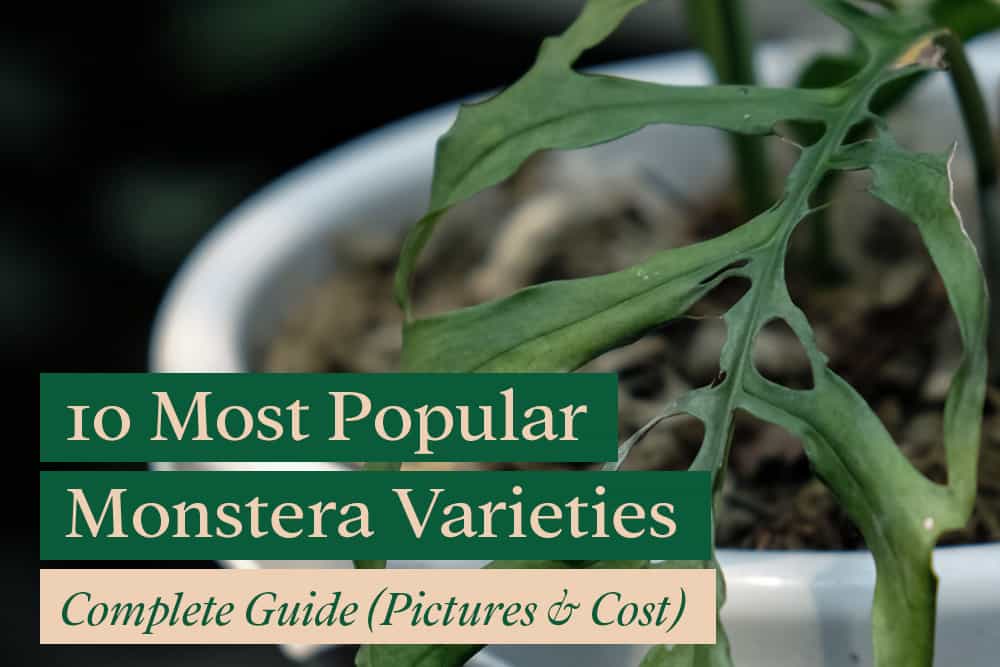
When people talk about Monstera, they are usually referencing the most common Monstera Deliciosa or Adansonii. But, would you believe there are over 50 species of Monstera out there?!
Every Monstera species is unique and beautiful. This article will go into the ten most popular Monstera species for casual plant moms and hardcore collectors alike.
This article will look at these ten most popular Monstera varieties:
| Monstera Varieties | Rarity | Price Range (USD$) |
|---|---|---|
| Monstera Deliciosa | ⭑✩✩✩✩ | $20 to $100 USD |
| Monstera Borsigiana | ⭑✩✩✩✩ | $20 to $100 USD |
| Monstera Adansonii | ⭑✩✩✩✩ | $20 to $50 USD |
| Monstera Peru | ⭑✩✩✩✩ | $20 to $50 USD |
| Monstera Dubia | ⭑⭑✩✩✩ | $50 to $200 USD |
| Monstera Pinnatipartida | ⭑⭑✩✩✩ | $100 to $300 USD |
| Monstera Siltepecana | ⭑⭑✩✩✩ | $50 to $200 USD |
| Monstera Standleyana | ⭑⭑⭑✩✩ | $50 to $200 USD |
| Monstera Acuminata | ⭑⭑⭑✩✩ | $100 to $250 USD |
| Monstera Obliqua | ⭑⭑⭑⭑⭑ | above $5,000 USD |
Note: Some of the “species” we will discuss here are actually just a sub-species of another one; some (especially when talking about variegation) are a “form” or a “cultivar.” Monstera taxonomy tends to be confusing because people will blend the Latin names with common names to produce a new nickname that isn’t quite right!
Let’s get started!
Also Read: Monstera Care 101 – Complete Guide for First Monstera Parents
1. Monstera Deliciosa
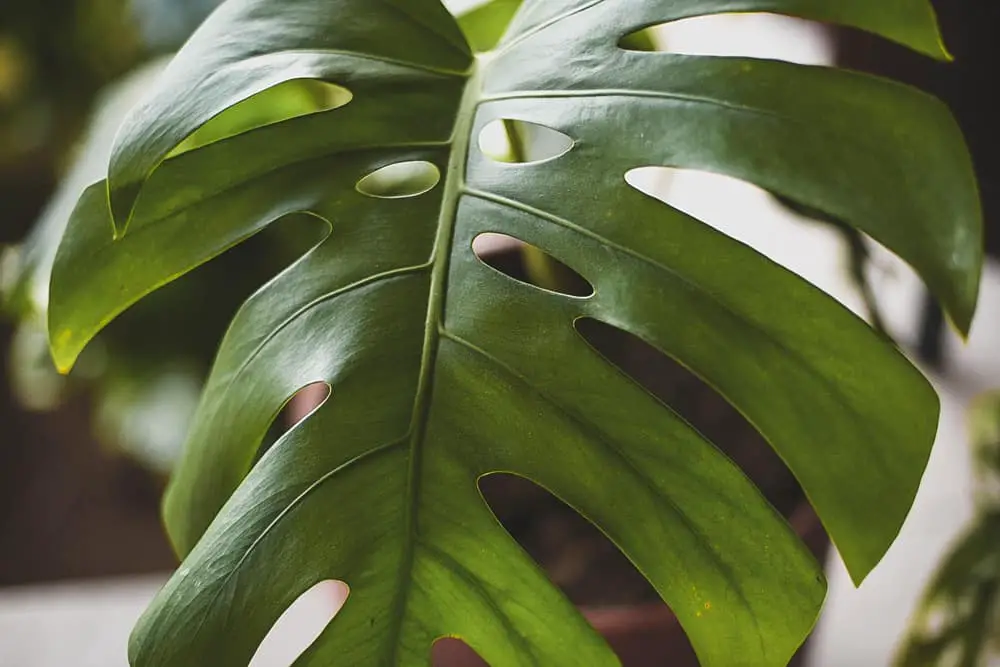
Other known names
Monstera Deliciosa is also called
- Swiss Cheese Plant
- Cheese Plant
- Hurricane Plant
- Windowleaf Plant
- delicious monster
- fruit salad plant
- fruit salad tree
- ceriman
- monster fruit
- Mexican breadfruit
- (incorrectly) split-leaf philodendron
Distinguishing features
Monstera Deliciosa will grow up to 20 m (66 feet) tall by climbing up the trunk of a tree in the wild. It grows big, glossy, green leaves that can grow up to 90 cm (3 feet) long and 75 cm (30 inches) wide.
The leaves grow holes or split called fenestrations on mature plants, a trait common to Monstera varieties. For Monstera Deliciosa, the fenestrations often extend all the way to the edge of the leaf.
Monstera Deliciosa will flower and produce a fruit known as a Monstera fruit or Mexican breadfruit in the right conditions. The flower looks like a giant version of a Peace Lily flower (they are from the same Araceae plant family, after all) with a central spathe or spike covered by a cream-colored hood known as the spadix. These flowers are no more than 15 cm (6 inches) tall.
When pollinated, the flower produces a fruit that looks just as weird. The Monstera fruit is shaped like an ear of corn, but its surface is covered in alien, giraffe-like, hexagonal scales. As the fruit ripens from the bottom to the top, these scales pop off to reveal the edible, white kernels that taste like a blend of pineapple and banana.
Care tips
Monstera Deliciosa will not grow quite as large when grown in the home and will not flower.
Due to its size, it likes to grow up a moss pole or similar structure to support its heavy growth.
Monstera Deliciosa prefers bright, indirect light. It is susceptible to root rot, and therefore needs a pot with adequate drainage.
Price Range
Depending on the plant’s maturity, Monstera Deliciosa can cost from about $20 USD to over $100 USD. If you want to start with a cutting and raise it all on your own, that cost goes down to about $10 or $15 USD.
Fun Facts
Sometimes in the wild, Monstera’s main stem will rot away at the bottom. But, as long as its aerial roots have reached the ground, they can take over the job of absorbing all the necessary water and nutrients!
Variegated cultivars
The popular Thai Constellation variety of Monstera is a cultivar of Monstera Deliciosa. This variety will have the same large leaves as your typical Monstera Deliciosa, except with beautiful creamy speckles scattered across the leaves like a constellation. Produced in a Thai lab via tissue culture, the variegation in this variety is stable, making it easier to care for than other variegated cultivars.
2. Monstera Borsigiana
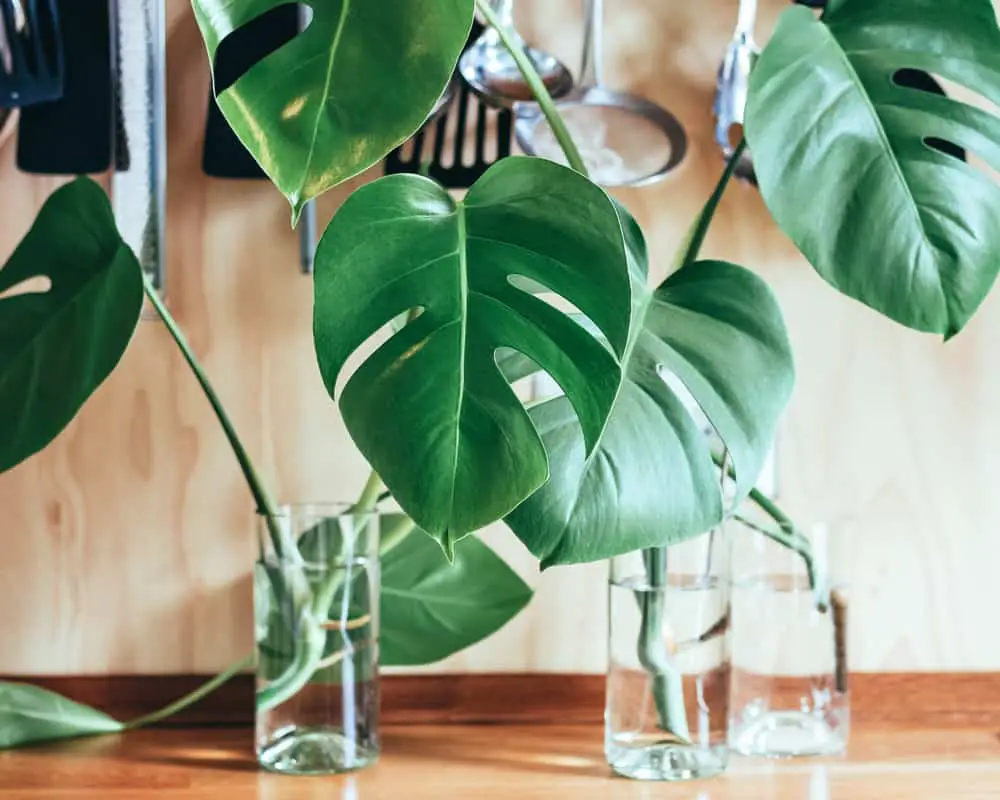
Other known names
- Latin Name: Monstera deliciosa f. borsigiana
Distinguishing Features
Borsigiana is a sub-form of Monstera Deliciosa with smaller leaves, thinner stems, and a longer internode (the leaves grow further apart on the stem). It also tends to grow faster than Monstera deliciosa.
While scientists have not determined this to be a different Monstera species, it certainly grows differently enough to give it a common name.
This Monstera form is known to be more of a climber, and its thinner stem responds very well to vertical support like a moss pole.
Variegated Cultivars
Monstera Borsigiana is most well-known for their variegated counterpart known as Albo Borsigiana. This beautiful cultivar has become extremely popular in the last few years, so much than even a small piece of the stem can be sold online for hundreds of dollars!
The variegation on Albo’s leaves ranges from dark green to white, and shades of green in between. Some leaves have a marbling effect, with all the different shades mixing together, and other leaves have big patches of pure white like a half-moon.
This variegation is caused by a natural mutation and is carried on through cloning and propagation. For this reason, the variegation in Monstera Albo Borsigiana is unstable. Albo requires that you maintain its variegation by pruning back new leaves that are too green or too white.
Care Tips
Because Monstera Borsigiana is a climbing form, it needs to have vertical support such as moss pole or stake to keep it growing upright. Its stem is not as thick as other Monstera varieties, so it will need extra help to keep from flopping out of its pot onto the floor.
Other than that, Borsigiana has similar light and water requirements to regular Monsteras. Give it bright, indirect light, and keep the soil from becoming waterlogged, and you should be good. It may need some extra pruning to keep the variegation in check.
Price Range
These Albo babies are expensive!
Even a piece of stem with one node—some people refer to this as a “wet stick”—can cost a few hundred dollars.
A mature Albo Borgisiana will cost over a thousand US dollars! And the prices are only going up as this variety is extremely popular.
On the other hand, a non-variegated Monstera Borsigiana will cost about the same as Monstera Deliciosa.
3. Monstera Adansonii
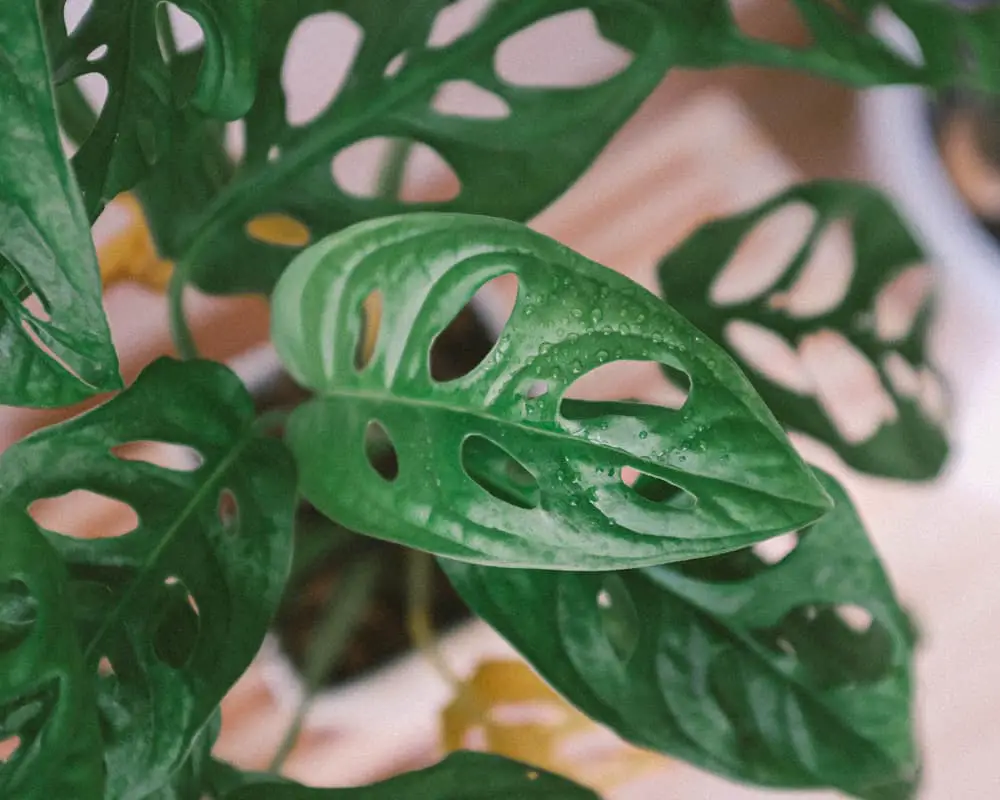
Other known names
- Swiss cheese plant (yes, it shares a nickname with Monstera deliciosa!)
- Swiss cheese vine
- Adanson’s Monstera
- Five holes plant
- Monkey mask
Distinguishing Features
Monstera Adansonii is differentiated from Monstera Deliciosa by its smaller, narrower leaves and the fact that all of its leaf perforations remain closed.
This variety can climb up to around 4 meters, but its smaller leaves and shorter petioles (leaf stems) make the whole plant feel much smaller than Monstera Deliciosa.
For comparison, its leaves grown indoors are about the same size as your hand. In the wild they will grow bigger, but still not as wide or as heart-shaped as Monstera Deliciosa.
Monstera Adansonii and Monstera Obliqua look very similar and are commonly confused. Obliqua’s holes are much bigger; even some say they are more hole than leaf!
Care Tips
This petite Monstera vine is easy to care for! You could train it up a moss pole like you would for other Monstera varieties, or you could decide to let its vines hang down over the side of the pot for a fuller look. These are a great candidate for a macrame plant hanger!
As for any Monstera variety, Adansonii doesn’t like to be waterlogged, so make sure to give it lots of drainage in the pot. It will appreciate bright, indirect light.
Price Range
Depending on the size of the plant, Monstera Adansonii will cost between $20 and $50 USD. That’s for the whole plant, not just a baby cutting. Adansonii is a very economical option if you want to get a Monstera.
Fun Facts
This variety will also produce edible fruit, similar to the Deliciosa if grown in the right conditions.
Variegated Cultivars
There is one known variegated cultivar of Monstera Adansonii known as ‘Archipelago.’ This was caused by a random mutation in someone’s houseplant Monstera in Sweden. The owner has an Instagram page dedicated to their Monstera.
The extreme rarity of this cultivar paired with surging demand for variegated plants means that cuttings are very expensive. As of December 2020, a two-leaf stem cutting is up for bid on eBay for $4,800 USD.
4. Monstera Peru
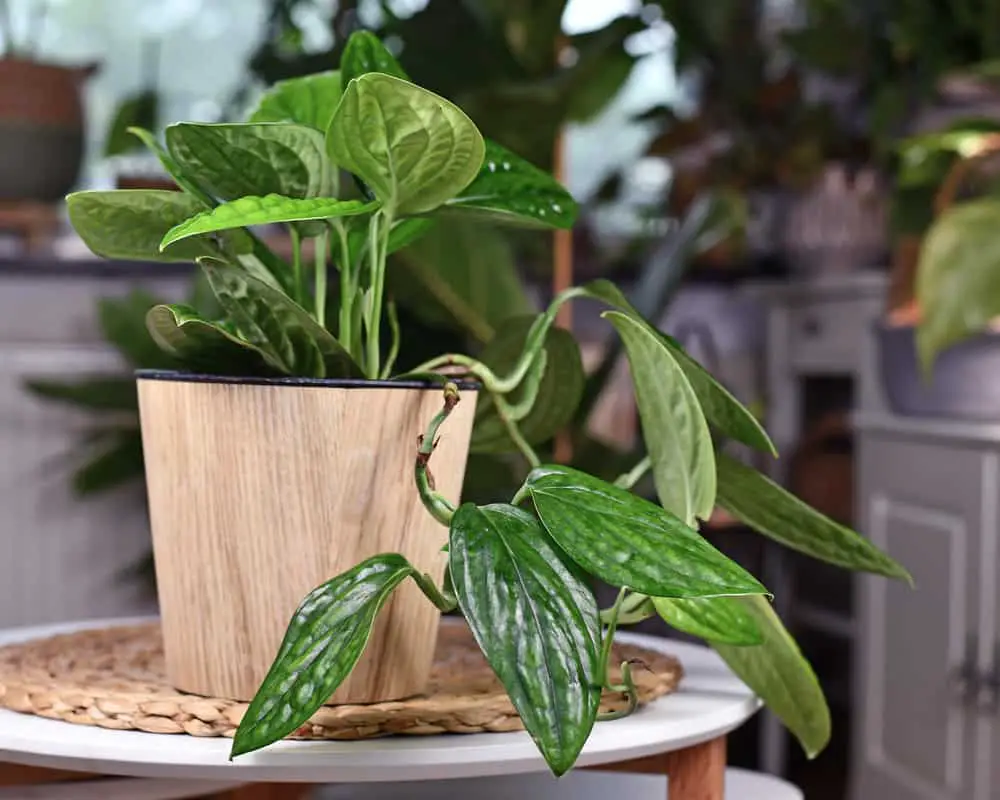
Other known names
Monstera Karstenianum
Distinguishing Features
Monstera Peru has small, leathery, puckered leaves that shine in the light. They are thicker than you would expect and unusually rigid. These Monsteras do not have fenestrations in the leaves!
Like Adansonii, Monstera Peru grows like a vine and will be happy with either a supportive moss pole or a hanging basket.
Monstera Peru looks similar to Monstera Pinnatipartita when young, but as it matures its leaves grow to be wider and rounder.
Care Tips
Monstera Peru care requirements are very similar to its cousins. Give it bright, indirect light, and make sure not to overwater it.
It will grow faster if given vertical support, although it is not necessary for this variety.
Price Range
Monstera Peru will cost between $20 and $50 USD. You can find both cuttings and young plants on the market online.
Variegated Cultivars
Monstera Peru does have a variegated cultivar, but it doesn’t have a unique name. Like all other variegated Monstera (except for ‘Thai Constellation’), this is a mutated chimaera, meaning the origin of the variegation was a spontaneous cellular mutation.
Because this variety is not as popular as the Deliciosa or Borsigiana, its variegated counterpart is not too expensive. You can find them online for about $60 USD.
5. Monstera Dubia

Other known names
Shingle Plant
Distinguishing Features
Monstera Dubia is another variety that is not commonly known. In its juvenile form (what you are likely to see as a houseplant), Dubia has smaller heart-shaped leaves which feature both light and dark green.
True to its nature, this Monstera climbs up trees with its aerial roots to reach better sunlight.
As it grows, its leaves alternate between the left and right side of the stem, giving it a neat and tidy appearance.
Dubia reveals its mature form once it reaches up high enough to get lots of light. A fully-matured Dubia’s leaves grow larger, turn deep green, and develop intense fenestrations. Once again, this is not likely to happen to Dubias raised as a houseplant.
Fun Facts
This variety is sometimes called a Shingle Plant because of the way its leaves press against the tree trunk as the vine climbs up.
Care Tips
To accentuate Dubia’s unique shingle-like leaves, you should provide it with a moss pole or other kind of support for it to grow up.
As it grows, it will press its leaves against the surface of its “tree.” Some vendors sell this variety growing up a small plank of wood to showcase its growth pattern.
Price Range
This Monstera variety is fairly uncommon, so it tends to be a little expensive. You can find a young Dubia online for $50 to $200 USD. As always, the size of the plant will play a large role in the overall cost.
6. Monstera Pinnatipartita
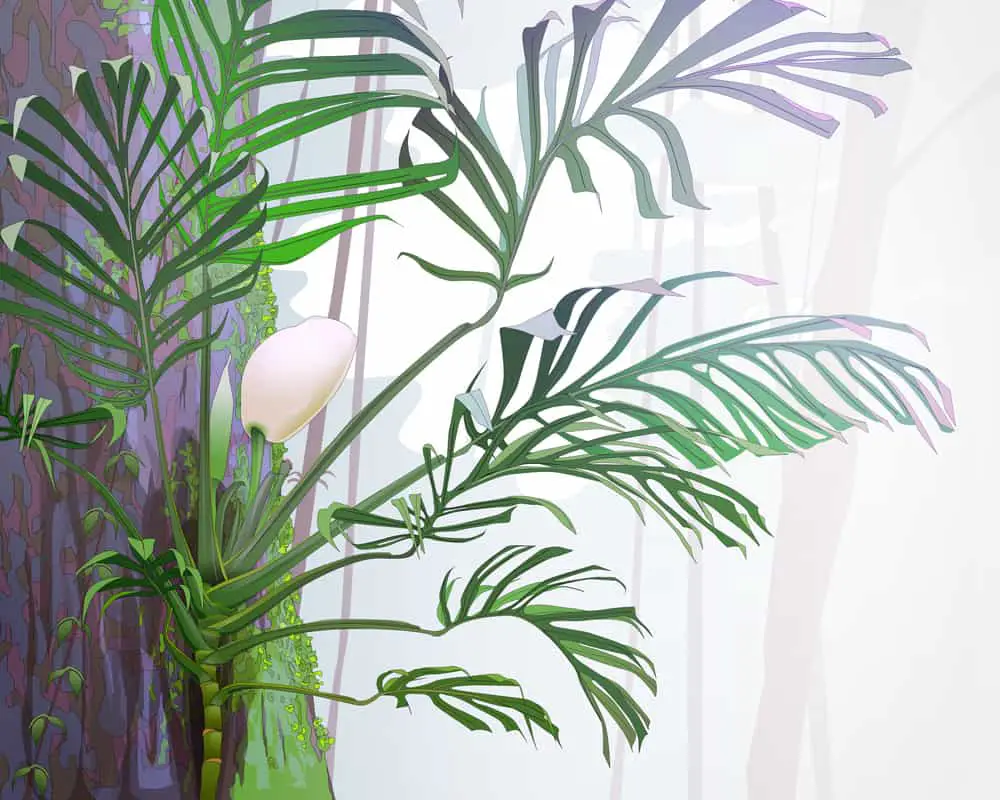
Distinguishing Features
Monstera Pinnatipartita is another bigger variety. Like the Deliciosa, it has a more compact stem growth with a shorter internode spacing. This means it grows less like a vine. Its nodes are hard to see underneath the tightly-stacked leaf petioles.
Pinnatipartita’s leaves are identified by its deep slots which cut from the leaf edge all the way to the center rib. This differentiates them from Deliciosa, whose slots don’t go all the way in, and who still have some round holes near the center leaf rib at maturity.
Care Tips
Pinnatipartita has the same light, soil, and water requirements as other Monsteras. It is not likely going to need a moss pole due to its compact growth pattern. This one is a slow creeper.
Price Range
A young Monstera Pinnatipartita is harder to find, so they are a bit more expensive. They will cost somewhere between $100 and $300 USD.
7. Monstera Siltepecana

Distinguishing Features
Monstera Siltepecana is small and rarer variety of Monstera. It has silvery green leaves with darker green along its veins and edges, similar to the Dubia.
In contrast to the Dubia, Siltepecana’s leaves are longer and pointier at the tip. In its juvenile form, its leaves will not have any holes. Those develop if the Monstera can grow up toward the light and transition into its mature forMonstera
Care Tips
If you want to see your Monstera Siltepecana grow big, mature leaves with fenestrations, you need to give it a moss pole or other support to climb up. It will need a few years of good growing conditions to reach its mature stage.
If you like its juvenile leaves just the way they are, you can grow Siltepecana as a trailing plant and let its vines hang over the edge of the pot.
Price Range
You can find a young Monstera Siltepecana online for $20 to $40 USD.
8. Monstera Standleyana

Other known names
Some people refer to this species incorrectly as Philodendron cobra.
Distinguishing Features
Standleyana is a naturally variegated Monstera vine. Its dark green leaves have small spots and streaks that can be creamy, white, or yellow in color.
The leaves are long and narrow, very different from the iconic heart-shaped leaf of Monstera Deliciosa. Fenestrations start to appear once the plant has reached a mature size.
Standleyana is a slower-growing variety compared to other Monsteras. Another thing that makes this Monstera different is how its leaves like to point upward rather than hang down towards the ground.
Care Tips
Because of its variegated leaves, Monstera Standleyana may need extra light to make up for the lack of chlorophyll in the lighter leaf sections.
This variety may be grown as a runner, but it will thrive if given some kind of support to grow up.
Variegated Cultivars
There are a few variations in how Standleyana’s variegation is presented.
- Variegated White has white specks on its leaves and stems.
- Albo Variegata has white specks as well as larger sections of white.
- Variegated Yellow has yellow or creamy specks and splashes on the leaves.
Price Range
There is a wide range in price for Monstera Standleyana. It ranges from $25 to $200 USD or more.
9. Monstera Acuminata
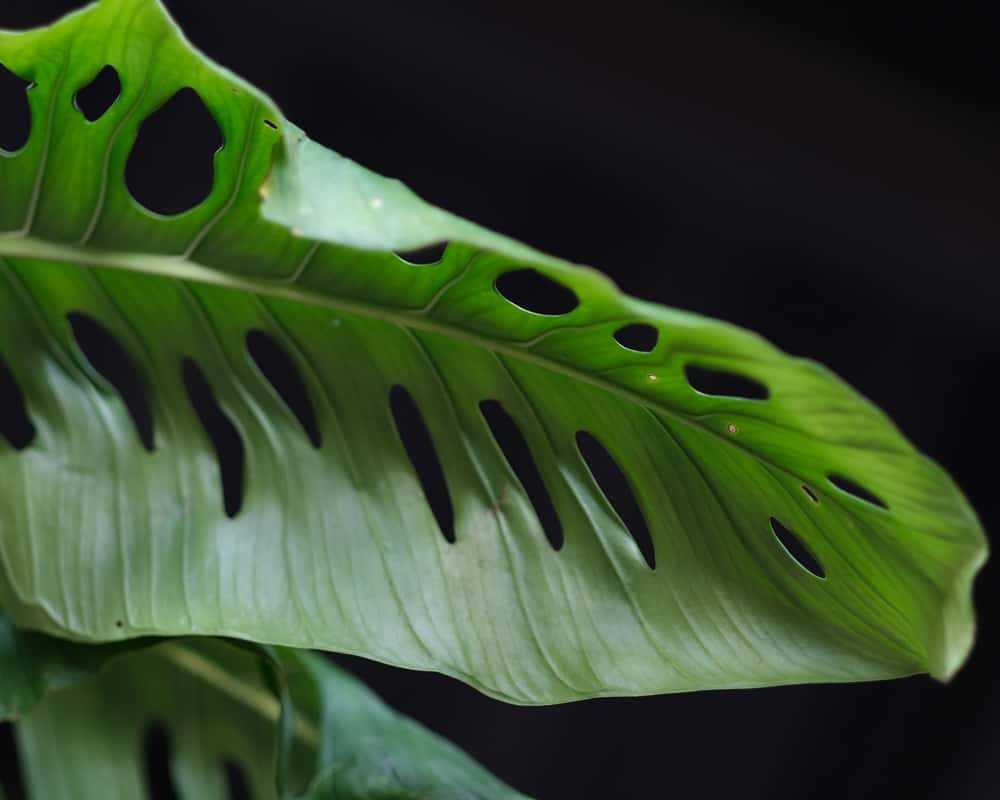
Other known names
- Shingle plant
- Monstera karwinskyi
- Monstera grandifola
- Monstera viridispatha
Distinguishing Features
Monstera Acuminata looks similar to Monstera Adansonii by the way the holes in the leaves do not reach the edges.
You can tell the difference between these species by the overall shape of Acuminata’s leaves. Their leaves are defined by a curve in the central rib, where one side of the leaf ends up wider than the other (and the wider side tends to have more fenestrations).
This variety grows as a “shingle plant” as a juvenile; mature specimens develop larger, perforated leaves which no longer adhere to the host tree’s trunk. It does not develop holes in its leaves until they grow to be about a foot long.
Care Tips
To accentuate this variety’s shingle-like leaves, you should give it a support to grow up, like a moss pole or a trellis.
Price Range
Monstera Acuminata is less common online; there are not many listings for this variety. The prices range from $100 to $250 USD.
10. Monstera Obliqua

Other known names
Unicorn Plant (because it’s so rare!)
Distinguishing Features
Monstera Obliqua is one of the rarest varieties, and it is often confused with Monstera Adansonii. While both of these Monsteras have lots of holes in their leaves, there are a couple of key differences.
Visually, Obliqua looks like it is more hole than leaf. Its fenestrations are so extreme that whatever leaf does exist looks almost like lace.
The other difference between Obliqua and Adansonii is the leaf sturdiness. Adansonii’s leaves will be thicker and sturdier, while Obliqua’s leaves are much more delicate.
Juvenile Obliqua will be nearly indistinguishable from Adansonii, as its leaf holes don’t develop fully until it is a few years old.
Care Tips
Monstera Obliqua is one of the most demanding varieties out there. It is not for the faint of heart!
It needs constant humidity to prevent its delicate leaves from crumbling away. Unless you live in the tropics, your Obliqua will need its own personal humidifier to keep the humidity above 80%. Without adequate humidity, its leaves will turn yellow, shrivel up, and fall off.
Like other Monsteras, it will burn in direct sunlight. It likes a peaty soil in a pot with great drainage.
Similar to variegated plants, Obliqua grows super slowly because it doesn’t have a lot of leafy surface area to produce chlorophyll.
Price Range
This is by far the most expensive Monstera species. A single cutting can cost $5,000 to $8,000 USD or even more.
Fun Facts
Obliqua is not as much of a climber as other Monstera species and will only climb a few meters high. It will also produce runners called stolons, which will drop down to the ground to root and produce a new plant. This is a rare feature for a Monstera!
When it flowers, Obliqua will produce up to 8 spadix flowers in a cluster. Other Monsteras only produce one or two spadices at a time.
Variegated Cultivars
There are no known variegated cultivars of Monstera Obliqua.
Related Questions:
Is Rhaphidophora Tetrasperma a Monstera?
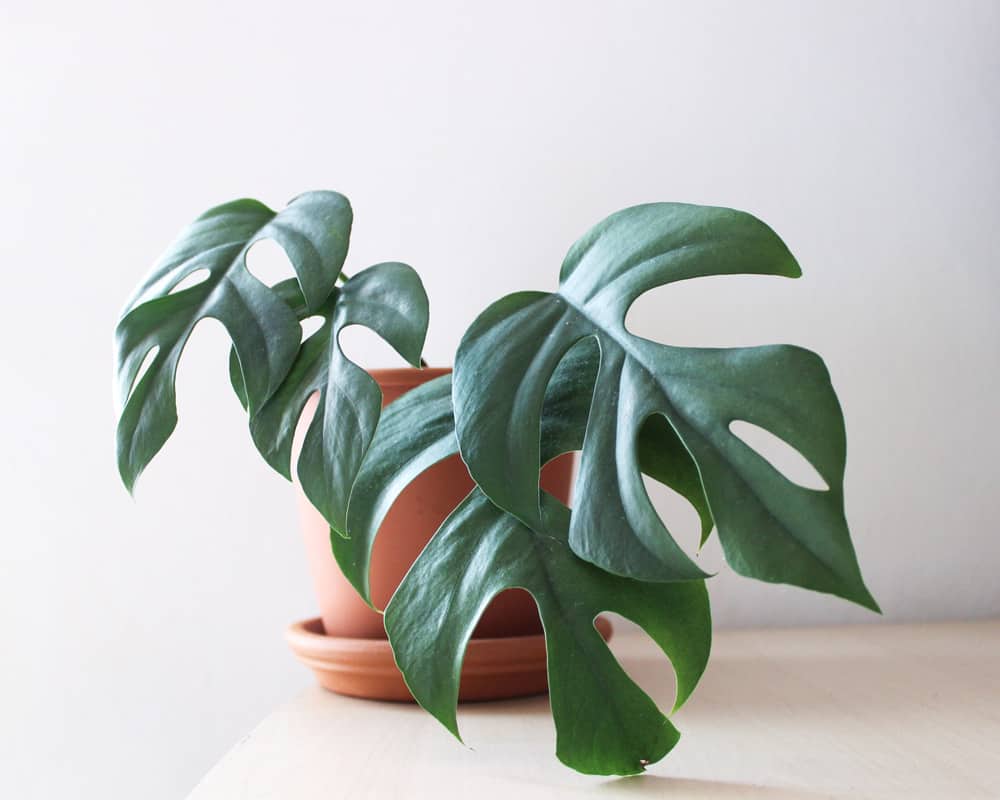
Rhaphidorphora Tetrasperma is often called a “dwarf Monstera,” although it is not technically a Monstera. It has a similar leaf shape to a Monstera. It is from the same Araceae family as Monstera, but it is in a different genus.
Is there any other varieties of Monstera?
As I mentioned earlier, there are over than 50 different Monstera varieties. You can check out Kaylee Ellen’s video to see other type of Monstera that is not as popular as already mentioned above!
